Wedding at Cana
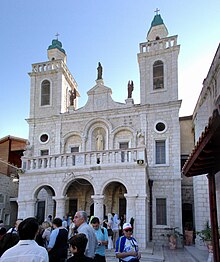
The wedding at Cana (also called the marriage at Cana, wedding feast at Cana or marriage feast at Cana) is the name of the story in the
In the Gospel account,
by turning water into wine at her request. The location of Cana has been subject to debate among biblical scholars and archaeologists; several villages in Galilee are possible candidates.The account is taken as evidence of Jesus' approval of marriage and earthly celebrations, and has also been used as an argument against teetotalism.
Biblical account
The second chapter of the
Interpretation
The Wedding Feast takes place in Cana shortly after the call of Philip and Nathanael. According to John 21:2,[e] Cana was Nathanael's hometown.[3]
Although none of the
The story has had considerable importance in the development of Roman Catholic theology. Bishop
The gospel account of Jesus being invited to a wedding, attending, and using his divine power to save the celebrations from disaster are taken as evidence of his approval for marriage and earthly celebrations. It has also been used as an argument against the teetotalism practiced among certain Protestant Christian sects.[6]
Interpreted allegorically, the good news and hope implied by the story are in the words of the steward of the Feast when he tasted the good wine, "Everyone serves the good wine first, and then the inferior wine after the guests have become drunk. But you have kept the good wine until now" (
Some commentators have speculated about the identity of the unnamed bridegroom. One tradition, represented by
Studying
The view of the valley looking out towards
The German theologian
- The power of Mary's intercession. This first miracle, which confirmed the faith of our Lord's disciples, was wrought at Mary's intercession, for it was by her persuasion that He first manifested His glory by a striking miracle at Cana instead of at Jerusalem. Let us contemplate Mary's compassion on the distress of the poor bride and bridegroom, her living faith in the omnipotence of Jesus, and her confidence in His goodness.
- Matrimony. By His presence at the marriage-feast of Cana Jesus honoured and sanctified marriage, which had already been instituted in Paradise.
- Lawful pleasures. The fact of our Lord taking part in the marriage-feast teaches us that it is lawful and pleasing to God that we should take part in innocent recreations and harmless pleasures, rejoicing with those who rejoice.
Identification of biblical Cana
The exact location of "Cana in Galilee" (
The main candidates for the town from the Gospel of John are:
- Kafr Kanna, in Galilee, locally identified at least since the 8th century with the biblical location;[24]
- Khirbet Qana, also in Galilee;[24][25]
- Qana, southern Lebanon,[23] in an area that was part of historical Galilee.
According to the Catholic Encyclopedia of 1914, a tradition dating back to the 8th century identifies Cana with the modern Arab town of Kafr Kanna, in Galilee, about 7 km (4.3 mi) northeast of Nazareth,[26] in today's Israel.
The ruined village of Khirbet Qana (Kanet el-Jelil), about six miles (9.7 km) further north,[27] is an option presented as certain by William F. Albright in 1923,[28] whose name "Qana" is also etymologically closer to Cana than "Kanna".[24]
Some Lebanese Christians, especially the Lebanese Melkites (Greek Catholics), supported by their Church, believe the southern Lebanese village of Qana to have been the actual location of this event.[23]
The spring of 'Ain Kanah ("Kanah Spring") near the village of Reineh, immediately northeast of Nazareth, has been proposed as an equally likely site by Conder in 1878,[29] but has little going for it and has been rejected in more recent scholarship as a candidate.[25]
Vessels and beverage
Stone jars
Many throughout history have sought to recover the lost jars. On December 21, 2004, archaeologists reported finding in Kafr Kanna "pieces of large stone jars of the type the Gospel says Jesus used when he turned water into wine".[30] But American scientists excavating the rival site of Khirbet Qana north of it, also claimed to have found pieces of stone jars from the time of Jesus.[30] Fellow archaeologist Shimon Gibson cast doubt on the value of such finds for identifying the town meant by John, since such vessels are not rare and it would be impossible to link a particular set of vessels to the miracle.[30] "Just the existence of stone vessels is not enough to prove that this is a biblical site."[30] Several stone jars of the type described by the Gospel of John were found for instance in Jerusalem: "At least six of them stood in the basement kitchen of the [1st-century CE] 'Burnt house'. They were shaped and finished on a very big lathe, given a pedestal foot and simple decoration. Such stone jars would hold large quantities of water for washing and kitchen needs. Flat discs of stone served as lids. The jars at Cana may have been similar to these", wrote Alan Millard.[31]
Wine or beer
In the journal Biblical Archaeology Review, Michael Homan argued that biblical scholars had misinterpreted early texts, translating to 'wine' when the more sensible translation would have been 'beer'.[32] However, this has been dismissed by other writers, who pointed out that the Greek oinos always means wine, and that the word sikera was available if the gospel author wanted to refer to barley beer.[33][34][35]
The Coptic Orthodox Church, alone among the apostolic churches, teaches that the wine was non-alcoholic.[36] However, the second century Coptic Saint Clement of Alexandria would appear to indicate the opposite when he states that, although the Lord approved of drinking wine, he did not approve of drunkenness.[37]
Feast
The
Influence
In art
Depictions of The Wedding or Marriage at Cana are numerous in art history.
-
Marriage at Cana, c. 1500,Musée du Louvre, Paris
-
The calling of Apostle John at the Marriage at Cana, c. 1530, Jan Cornelisz Vermeyen
-
Marriage at Cana, 1561,Jacopo Tintoretto
-
Musée du Louvre, Paris
-
Marriage at Cana, 1566, Giorgio Vasari
-
Marriage at Cana byGiotto di Bondone, 14th century
-
Print about the Wedding at Cana. Made at the end of the 16th century. Preserved in the Ghent University Library.[40]
-
The Marriage at Cana by Maerten de Vos, c. 1596
Saint Columba miracle
Sixth-century Irish missionary Saint
See also
- Chronology of Jesus
- Life of Jesus in the New Testament
- Ministry of Jesus
- Miracles of Jesus
Notes
Bibical verses cited
References
- ^ Loos, Hendrik van der (1965). The Miracles Of Jesus. Brill Archive. p. 590. GGKEY:ZY15HUEX1RJ.
- ISBN 978-0-88141-193-5.
- ^ ISBN 978-0-9555654-0-3.
- ^ Towner, W. S. (1996). "Wedding". In P. J. Achtermeier (ed.). Harper Collins Bible Dictionary. San Francisco: Harper. pp. 1205–1206.
- ^ a b Sheen, Fulton J. (1952). "The Marriage Feast At Cana, in The World's First Love". www.catholictradition.org.
- ^ Geisler, N. L. (1982). "A Christian Perspective on Wine-Drinking". Bibliotheca Sacra. 49.
- ^ Smith, D. M. (1988). "John". In Mays, J. L. (ed.). Harper's Bible Commentary. San Francisco: Harper. pp. 1044–1076.
- ISBN 0-9662080-0-5.
- ^ Hall, James (1979). "Marriage at Cana". Dictionary of Subjects and Symbols in Art (Revised ed.). New York: Harper & Row – via Columbia University.
- ISBN 9780199246847.
- ^ Spong, John Shelby (1992). Born of a Woman. Harper. pp. 187–199.
- ^ Hyde, Orson (6 October 1854), "Conference message", Journal of Discourses, 2: 82
- ISBN 978-0-7369-1968-5.
- ISBN 978-1-4497-1210-5.
- ISBN 978-0-19-518140-1.
- ISBN 978-0-19-872648-7.
- ISBN 978-0-8028-2861-3.
- ISBN 978-0-06-208994-6.
- ^ Moore, Michael (2008-02-16). ""What good thing can come out of Nazareth?" (updated)". University of the Holy Land. Retrieved 2021-08-11.
- S2CID 44623301.
- ^ Knecht, Friedrich Justus (1910). . A Practical Commentary on Holy Scripture. B. Herder.
- ISBN 978-0-8028-4880-2.
- ^ a b c Salameh, Rima (29 January 1994). "Lebanese Town Lays Claim To Jesus Christ's First Miracle". Tulsa World. Retrieved 21 June 2021 – via Associated Press.
- ^ ISBN 978-90-5356-503-2. Retrieved 15 July 2021.
- ^ a b Laney, J. Carl (1977). The Identification of Cana of Galilee (PDF). Selective Geographical Problems in the Life of Christ (doctoral dissertation) (Thesis). Dallas Theological Seminary. pp. 91–92. Retrieved 15 July 2021.
- ^ Ward, Bernard (1908). . In Herbermann, Charles (ed.). Catholic Encyclopedia. Vol. 3. New York: Robert Appleton Company.
- ^ Ward, Bernard (1908). "Cana". Catholic Encyclopedia. New York: Robert Appleton Co. Retrieved 16 July 2021 – via Catholic Answers.
- S2CID 163409706.
- ^ Conder, Claude Reignier (1878). Tent Work in Palestine: A Record of Discovery and Adventure. R. Bentley & Son. p. 154.
- ^ The Associated Press. 21 December 2004. Retrieved 15 July 2021.
- ISBN 9780745937403. Retrieved 15 July 2021.
- ^ Homan, Michael M. (2010). "Did the Ancient Israelites Drink Beer?". Biblical Archaeology Review.
- ^ Kneale, Stephen (November 23, 2016). "Did Jesus actually turn water into beer?". Building Jerusalem.
- ISBN 9788184650259. Retrieved 14 April 2010.
- ISBN 9781556356995.
- ^ https://www.stvnashville.org/wedding-at-cana-of-galilee
- ^ https://suscopts.org/resources/literature/253/foreordination-tothe-transformation-of-the-bread-a/
- ^ https://www.stminahamilton.ca/blog1/2011/01/the-feast-of-the-wedding-in-cana-of-galilee
- ^ https://copticheritage.org/07-feast-of-cana-of-galilee/
- ^ "Bruiloft te Kana". lib.ugent.be. Retrieved 2020-09-28.
- ^ Adomnan of Iona (1995). Life of St Columba. Penguin.
Further reading
- Clark, Anne L. (2015). "Here Comes the Bride: Re-Envisioning the Wedding at Cana in the 12th Century". Church History and Religious Culture. 95 (2–3): 155–181. JSTOR 43946289.
- Gils, Félix (December 1986). "The Marriage Feast at Cana in the Commentary on St John". Spiritan Papers. 20 (20): 45–65. Article 8. PDF
- Tabor, James (27 April 2023). "Mark and John: A Wedding at Cana—Whose and Where?". Biblical Archaeology Review. Biblical Archaeology Society.
- Shea, Mark (September 10, 2012) "The Significance of the Wedding at Cana", National Catholic Register.

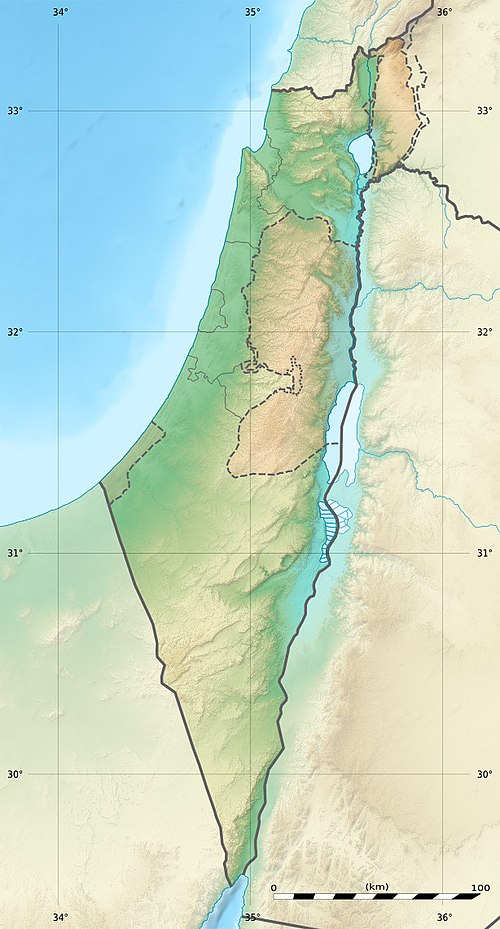


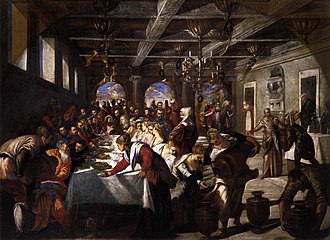
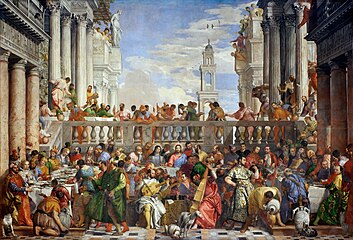
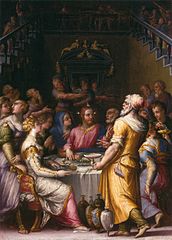

![Print about the Wedding at Cana. Made at the end of the 16th century. Preserved in the Ghent University Library.[40]](http://upload.wikimedia.org/wikipedia/commons/thumb/3/35/Bruiloft_te_Kana.jpg/168px-Bruiloft_te_Kana.jpg)

